Semiconductor Heterojunction-AgNPs Mediated Surface-Enhanced Raman Spectroscopy (SERS) Sensor for Portable Miniaturized Detection Platform
Abstract
:1. Introduction
2. Experimental Section
2.1. Chemicals
2.2. Preparation of ZIF-67 Nanosheet and Co3O4 Nanosheet
2.3. Preparation of Co3O4/Co3S4 Heterojunction Nanosheet
2.4. Synthesis of Co3O4/Co3S4/AgNPs Substrate
2.5. Characterization and SERS Measurements
2.5.1. Characterization of SERS-Active Substrates and Their Components
2.5.2. Testing SERS Activity Using 4-ATP Model Molecule
3. Results and Discussion
3.1. The Morphological Analysis and Structural Characterizations
3.2. The SERS Performances of the Co3O4/Co3S4/AgNPs
3.3. The SERS Performance Optimization of Co3O4/Co3S4/AgNPs
LOQ = 10 × N × Q/I
3.4. Practical SERS Detection of PS Nanospheres in Water Environment
4. Conclusions
Supplementary Materials
Author Contributions
Funding
Acknowledgments
Conflicts of Interest
References
- Sharma, S.; Basu, S.; Shetti, N.P.; Nadagouda, M.N.; Aminabhavi, T.M. Microplastics in the Environment: Occurrence, Perils, and Eradication. Chem. Eng. J. 2020, 408, 127317. [Google Scholar] [CrossRef]
- Kim, T.; Park, K.; Hong, J. Understanding the Hazards Induced by Microplastics in Different Environmental Conditions. J. Hazard. Mater. 2021, 424, 127630. [Google Scholar] [CrossRef]
- Dong, X.; Liu, X.; Hou, Q.; Wang, Z. From Natural Environment to Animal Tissues: A Review of Microplastics (Nanoplastics) Translocation and Hazards Studies. Sci. Total Environ. 2022, 855, 158686. [Google Scholar] [CrossRef]
- Lv, L.; He, L.; Jiang, S.; Chen, J.; Zhou, C.; Qu, J.; Lu, Y.; Hong, P.; Sun, S.; Li, C. In Situ Surface-Enhanced Raman Spectroscopy for Detecting Microplastics and Nanoplastics in Aquatic Environments. Sci. Total Environ. 2020, 728, 138449. [Google Scholar] [CrossRef]
- Mikac, L.; Rigó, I.; Himics, L.; Tolić, A.; Ivanda, M.; Veres, M. Surface-Enhanced Raman Spectroscopy for the Detection of Microplastics. Appl. Surf. Sci. 2022, 608, 155239. [Google Scholar] [CrossRef]
- Nayak, D.R.; Bhat, N.; Venkatapathi, M.; Umapathy, S. Signal Enhancement from Tunable SERS Substrates: Design and Demonstration of Multiple Regimes of Enhancement. J. Phys. Chem. C 2018, 122, 9134–9140. [Google Scholar] [CrossRef]
- Yue, T.; Li, S.; Xu, Y.; Zhang, X.; Huang, F. Interplay between Nanoparticle Wrapping and Clustering of Inner Anchored Membrane Proteins. J. Phys. Chem. B 2016, 120, 11000–11009. [Google Scholar] [CrossRef]
- Zhang, X.; Si, S.; Zhang, X.; Wu, W.; Xiao, X.; Jiang, C. Improved Thermal Stability of Graphene-Veiled Noble Metal Nanoarrays as Recyclable SERS Substrates. ACS Appl. Mater. Interfaces 2017, 9, 40726–40733. [Google Scholar] [CrossRef]
- Wang, Y.; Qiu, C.; Shen, C.; Li, L.; Yang, K.; Wei, Z.; Deng, H.-X.; Xia, C. Band Offset Trends in IV-VI Layered Semiconductor Heterojunctions. J. Phys. Condens. Matter 2022, 34, 195003. [Google Scholar] [CrossRef]
- Ma, L.; Zhang, Q.; Li, J.; Lu, X.; Gao, C.; Song, P.; Xia, L. Ag–ZnO Nanocomposites Are Used for SERS Substrates and Promote the Coupling Reaction of PATP. Materials 2021, 14, 922. [Google Scholar] [CrossRef]
- Kim, J.; Jang, Y.; Kim, N.-J.; Kim, H.; Yi, G.-C.; Shin, Y.; Kim, M.H.; Yoon, S. Study of Chemical Enhancement Mechanism in Non-Plasmonic Surface Enhanced Raman Spectroscopy (SERS). Front. Chem. 2019, 7, 582. [Google Scholar] [CrossRef] [PubMed]
- Lin, Y.; Liao, Y.; Chen, Z.; Connell, J.W. Holey Graphene: A Unique Structural Derivative of Graphene. Mater. Res. Lett. 2017, 5, 209–234. [Google Scholar] [CrossRef]
- Malaki, M.; Maleki, A.; Varma, R.S. MXenes and Ultrasonication. J. Mater. Chem. A 2019, 7, 10843–10857. [Google Scholar] [CrossRef]
- Jiang, Q.; Zhou, C.; Meng, H.; Han, Y.; Shi, X.; Zhan, C.; Zhang, R. Two-Dimensional Metal—Organic Framework Nanosheets: Synthetic Methodologies and Electrocatalytic Applications. J. Mater. Chem. A 2020, 8, 15271–15301. [Google Scholar] [CrossRef]
- Li, B.; Liu, Y.; Cheng, J. Facile Regulation of Shell Thickness of the Au@MOF Core-Shell Composites for Highly Sensitive Surface-Enhanced Raman Scattering Sensing. Sensors 2022, 22, 7039. [Google Scholar] [CrossRef] [PubMed]
- Sun, H.; Yu, B.; Pan, X.; Zhu, X.; Liu, Z. Recent Progress in Metal–Organic Frameworks-Based Materials toward Surface-Enhanced Raman Spectroscopy. Appl. Spectrosc. Rev. 2022, 57, 513–528. [Google Scholar] [CrossRef]
- Chen, Y.; Zhu, L.; Yang, Y.; Wu, D.; Zhang, Y.; Cheng, W.; Tang, X. Fabrication of a Metal Organic Framework (MOF)—Modified Au Nanoparticle Array for Sensitive and Stable SERS Sensing of Paraquat in Cereals. J. Food Sci. 2023, 88, 1769–1780. [Google Scholar] [CrossRef]
- Sun, Y.; Yu, X.; Hu, J.; Zhuang, X.; Wang, J.; Qiu, H.; Ren, H.; Zhang, S.; Zhang, Y.; Hu, Y. Constructing a Highly Sensitivity SERS Sensor Based on a Magnetic Metal—Organic Framework (MOF) to Detect the Trace of Thiabendazole in Fruit Juice. ACS Sustain. Chem. Eng. 2022, 10, 8400–8410. [Google Scholar] [CrossRef]
- Li, D.; Cao, X.; Zhang, Q.; Ren, X.; Jiang, L.; Li, D.; Deng, W.; Liu, H. Facile in Situ Synthesis of Core—Shell MOF@Ag Nanoparticle Composites on Screen-Printed Electrodes for Ultrasensitive SERS Detection of Polycyclic Aromatic Hydrocarbons. J. Mater. Chem. A 2019, 7, 14108–14117. [Google Scholar] [CrossRef]
- Zheng, G.; de Marchi, S.; López-Puente, V.; Sentosun, K.; Polavarapu, L.; Pérez-Juste, I.; Hill, E.H.; Bals, S.; Liz-Marzán, L.M.; Pastoriza-Santos, I.; et al. Encapsulation of Single Plasmonic Nanoparticles within ZIF-8 and SERS Analysis of the MOF Flexibility. Small 2016, 12, 3935–3943. [Google Scholar] [CrossRef]
- Huang, C.; Li, A.; Chen, X.; Wang, T. Understanding the Role of Metal—Organic Frameworks in Surface-Enhanced Raman Scattering Application. Small 2020, 16, 2004802. [Google Scholar] [CrossRef] [PubMed]
- Shu, T.; Wang, H.; Li, Q.; Feng, Z.; Wei, F.; Yao, K.; Sun, Z.; Qi, J.; Sui, Y. Highly stable Co3O4 nanoparticles/carbon nanosheets array derived from flake-like ZIF-67 asan advanced electrode for supercapacacitor. Chem. Eng. J. 2021, 419, 129631. [Google Scholar] [CrossRef]
- Zhang, M.; Meng, J.; Wang, D.; Tang, Q.; Chen, T.; Rong, S.; Liu, J.; Wu, Y. Biomimetic Synthesis of Hierarchical 3D Ag Butterfly Wing Scale Arrays/Graphene Composites as Ultrasensitive SERS Substrates for Efficient Trace Chemical Detection. J. Mater. Chem. C 2018, 6, 1933–1943. [Google Scholar] [CrossRef]
- Zhao, Q.; Zheng, Y.; Song, C.; Liu, Q.; Ji, N.; Ma, D.; Lu, X. Novel Monolithic Catalysts Derived from In-Situ Decoration of Co3O4 and Hierarchical Co3O4@MnOx on Ni Foam for VOC Oxidation. Appl. Catal. B Environ. 2019, 265, 118552. [Google Scholar] [CrossRef]
- Tang, S.; Wang, X.; Zhang, Y.; Courté, M.; Fan, H.J.; Fichou, D. Combining Co3S4 and Ni:Co3S4 Nanowires as Efficient Catalysts for Overall Water Splitting: An Experimental and Theoretical Study. Nanoscale 2018, 11, 2202–2210. [Google Scholar] [CrossRef] [PubMed]
- Zhang, L.; Weng, Y.-J.; Liu, X.; Gu, W.; Zhang, X.; Han, L. Fe(III) Mixed IP6@Au NPs with Enhanced SERS Activity for Detection of 4-ATP. Sci. Rep. 2020, 10, 5752. [Google Scholar] [CrossRef] [PubMed]
- Chen, Q.; Qin, L.; Shi, C.; Kang, S.-Z.; Li, X. A Stable and Plug-and-Play Aluminium/Titanium Dioxide/Metal-Organic Framework/Silver Composite Sheet for Sensitive Raman Detection and Photocatalytic Removal of 4-Aminothiophenol. Chemosphere 2021, 282, 131000. [Google Scholar] [CrossRef]
- Cao, J.; Zhao, D.; Mao, Q. A Highly Reproducible and Sensitive Fiber SERS Probe Fabricated by Direct Synthesis of Closely Packed AgNPs on the Silanized Fiber Taper†. Analyst 2017, 142, 596–602. [Google Scholar] [CrossRef]
- Wang, Q.; Xu, H.; Qian, X.; He, G.; Chen, H. Oxygen and Sulfur Dual Vacancy Engineering on a 3D Co3O4/Co3S4 Heterostructure to Improve Overall Water Splitting Activity. Green Chem. 2022, 24, 9220–9232. [Google Scholar] [CrossRef]
- Lin, P.-Y.; Wu, I.-H.; Tsai, C.-Y.; Kirankumar, R.; Hsieh, S. Detecting the release of plastic particles in packaged drinking water under simulated light irradiation using surface-enhanced Raman spectroscopy. Anal. Chim. Acta 2022, 1198, 339516. [Google Scholar] [CrossRef]
- Yan, Y.; Li, K.; Chen, X.; Yang, Y.; Lee, J.-M. Heterojunction-Assisted Co3S4@Co3O4 Core—Shell Octahedrons for Supercapacitors and Both Oxygen and Carbon Dioxide Reduction Reactions. Small 2017, 13, 1701724. [Google Scholar] [CrossRef] [PubMed]
- Wang, X.; Liu, C.; Li, Q.; Li, H.; Xu, J.; Chu, X.; Zhang, L.; Zhao, G.; Li, H.; Guo, P.; et al. 3D Heterogeneous Co3O4@Co3S4 Nanoarrays Grown on Ni Foam as a Binder-Free Electrode for Lithium-Ion Batteries. ChemElectroChem 2017, 5, 309–315. [Google Scholar] [CrossRef]
- Qin, Y.; Qiu, J.; Tang, N.; Wu, Y.; Yao, W.; He, Y. Controllable Preparation of Mesoporous Spike Gold Nanocrystals for Surface-Enhanced Raman Spectroscopy Detection of Micro/Nanoplastics in Water. Environ. Res. 2023, 228, 115926. [Google Scholar] [CrossRef] [PubMed]
- Jeon, Y.; Kim, D.; Kwon, G.; Lee, K.; Oh, C.-S.; Kim, U.-J.; You, J. Detection of Nanoplastics Based on Surface-Enhanced Raman Scattering with Silver Nanowire Arrays on Regenerated Cellulose Films. Carbohydr. Polym. 2021, 272, 118470. [Google Scholar] [CrossRef]
- Chang, L.; Jiang, S.; Luo, J.; Zhang, J.F.; Liu, X.H.; Lee, C.-Y.; Zhang, W. Nanowell-Enhanced Raman Spectroscopy Enables the Visualization and Quantification of Nanoplastics in the Environment. Environ. Sci. Nano 2022, 9, 54. [Google Scholar] [CrossRef]
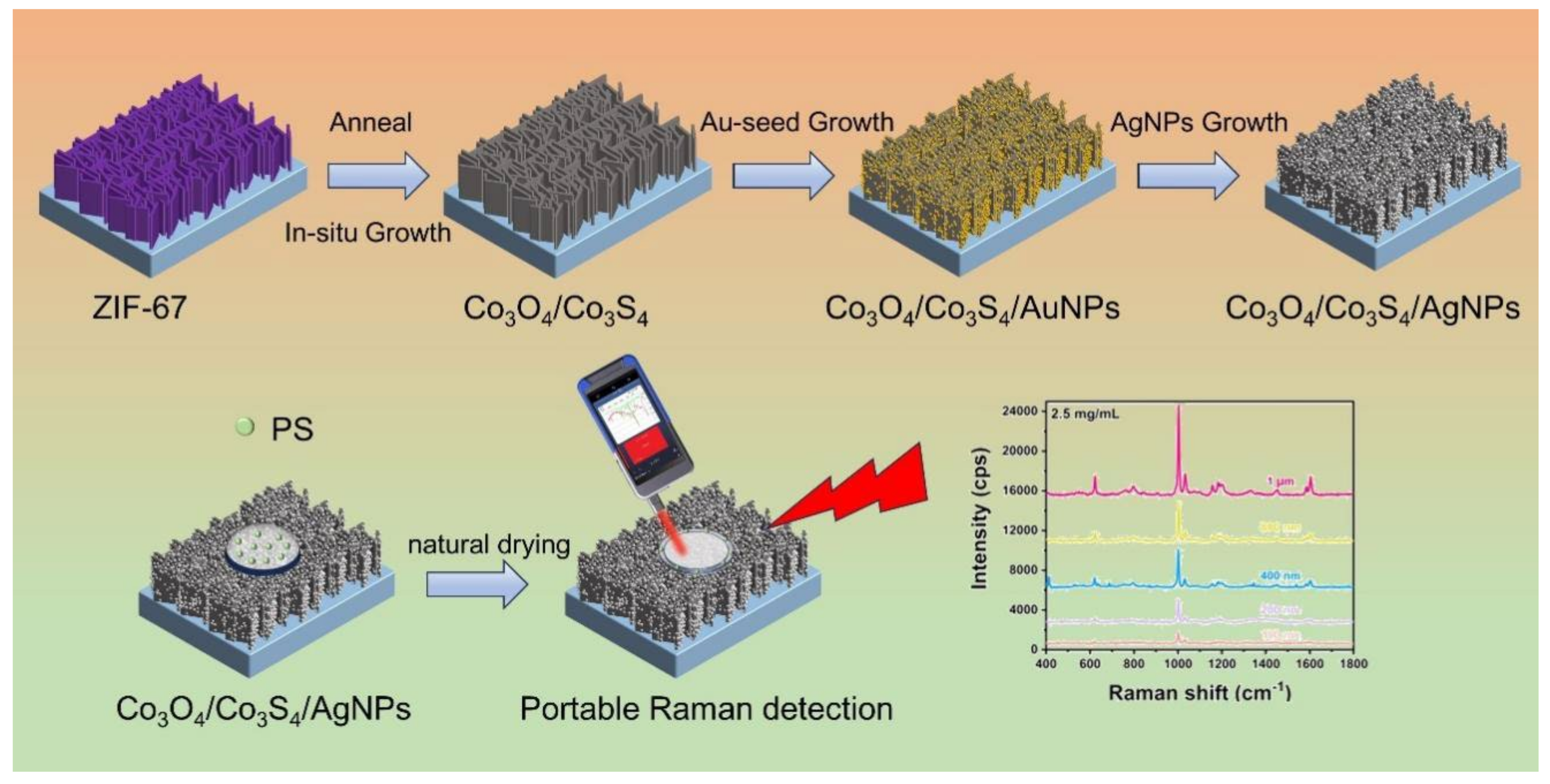
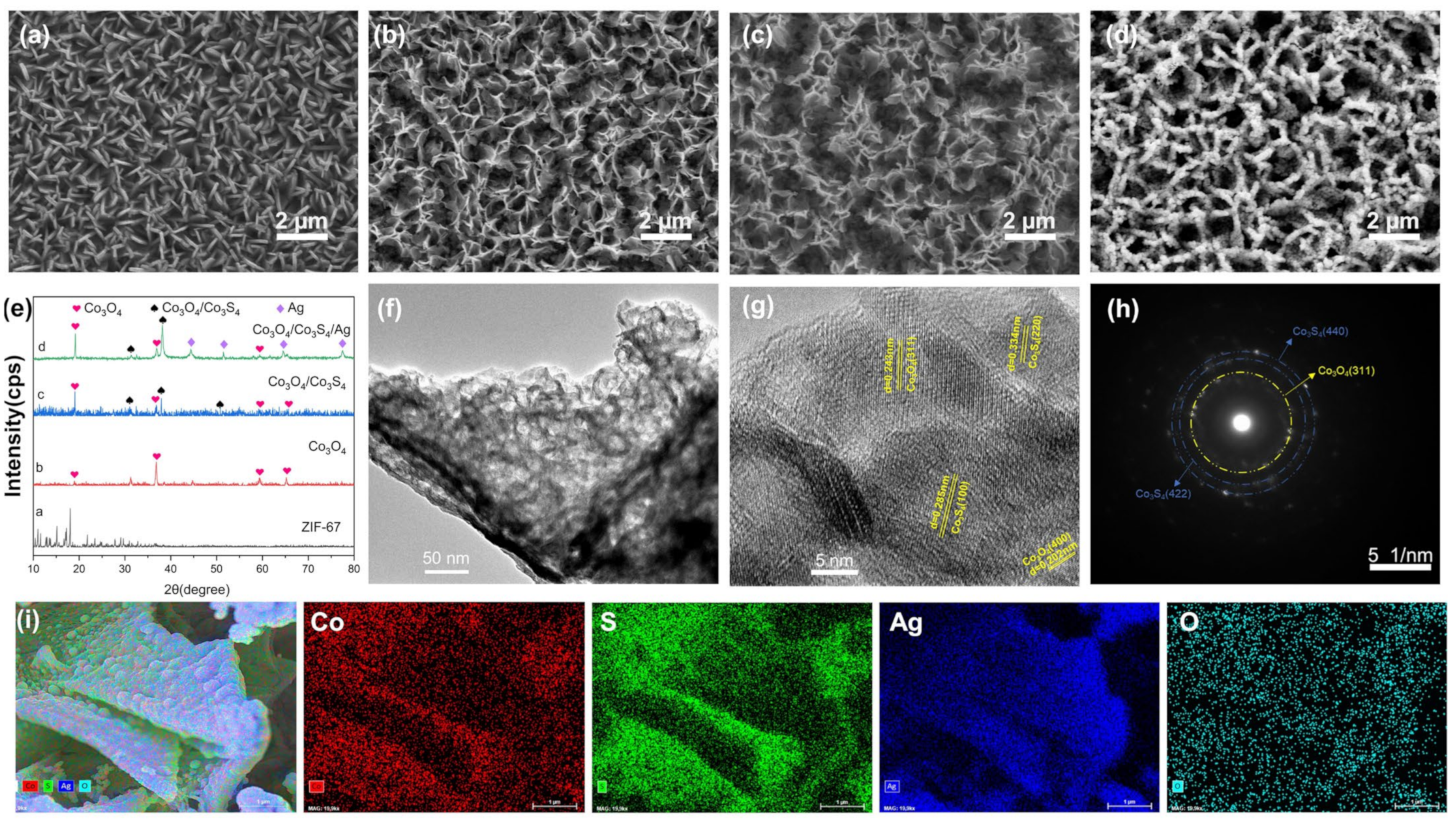
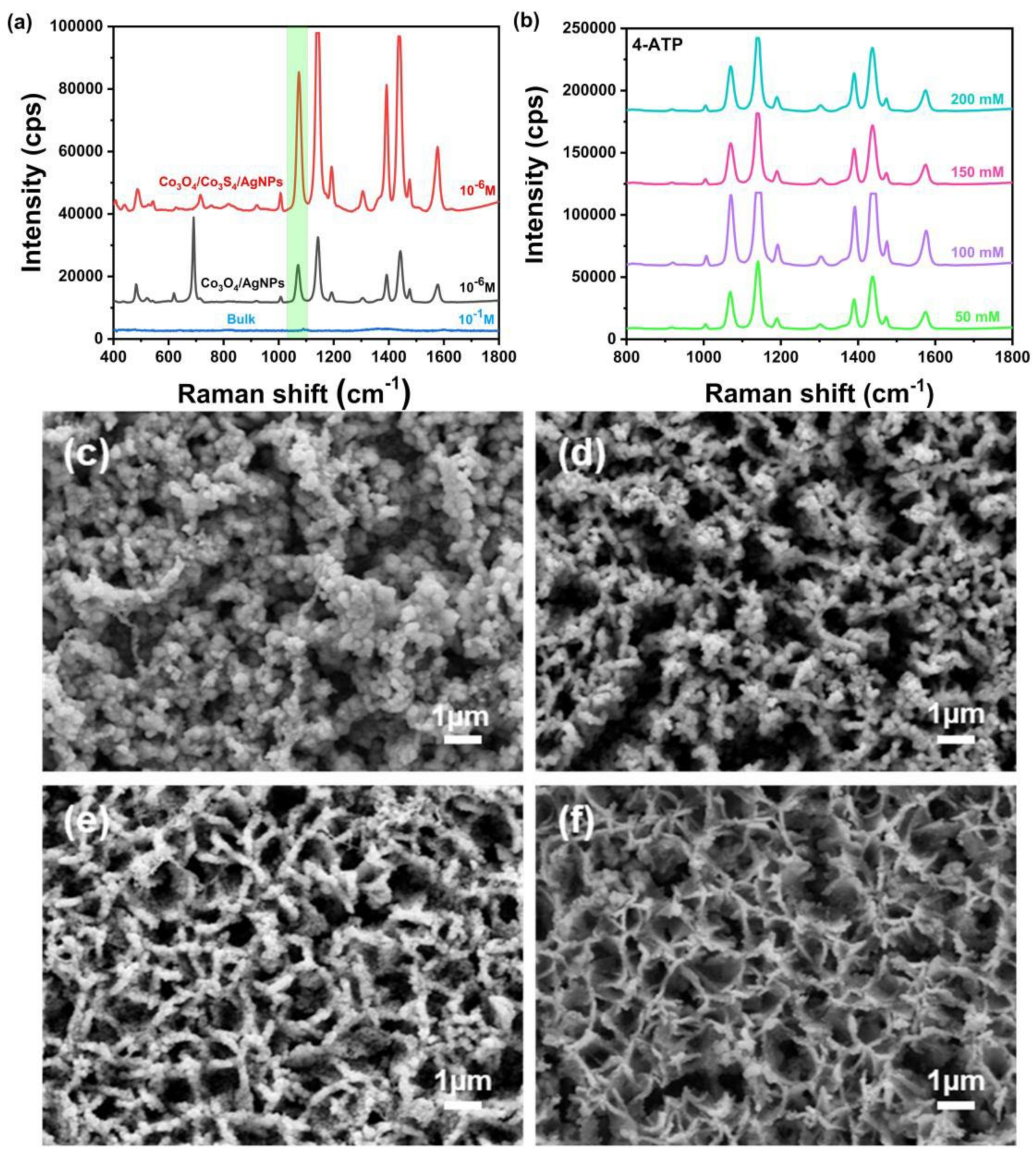
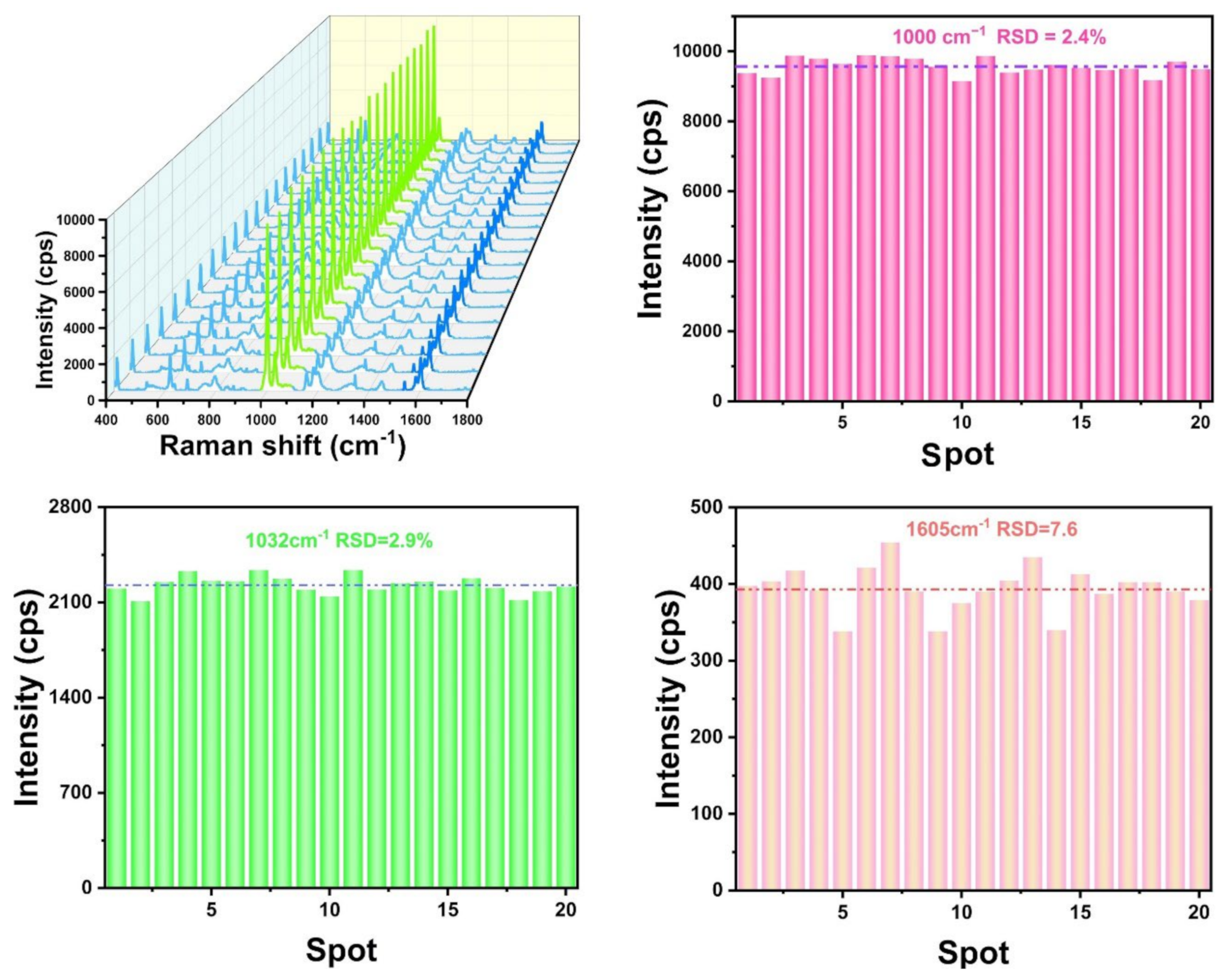
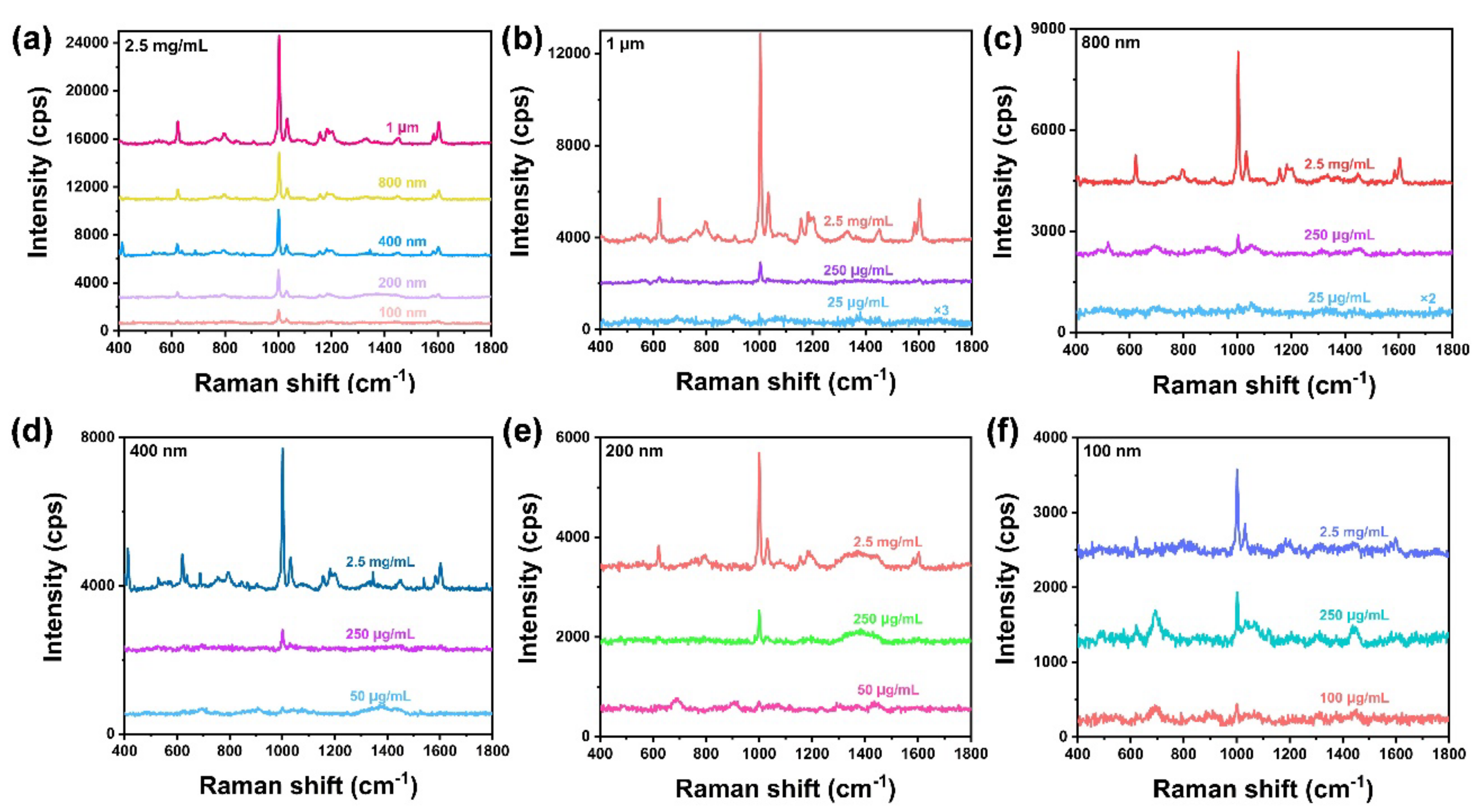
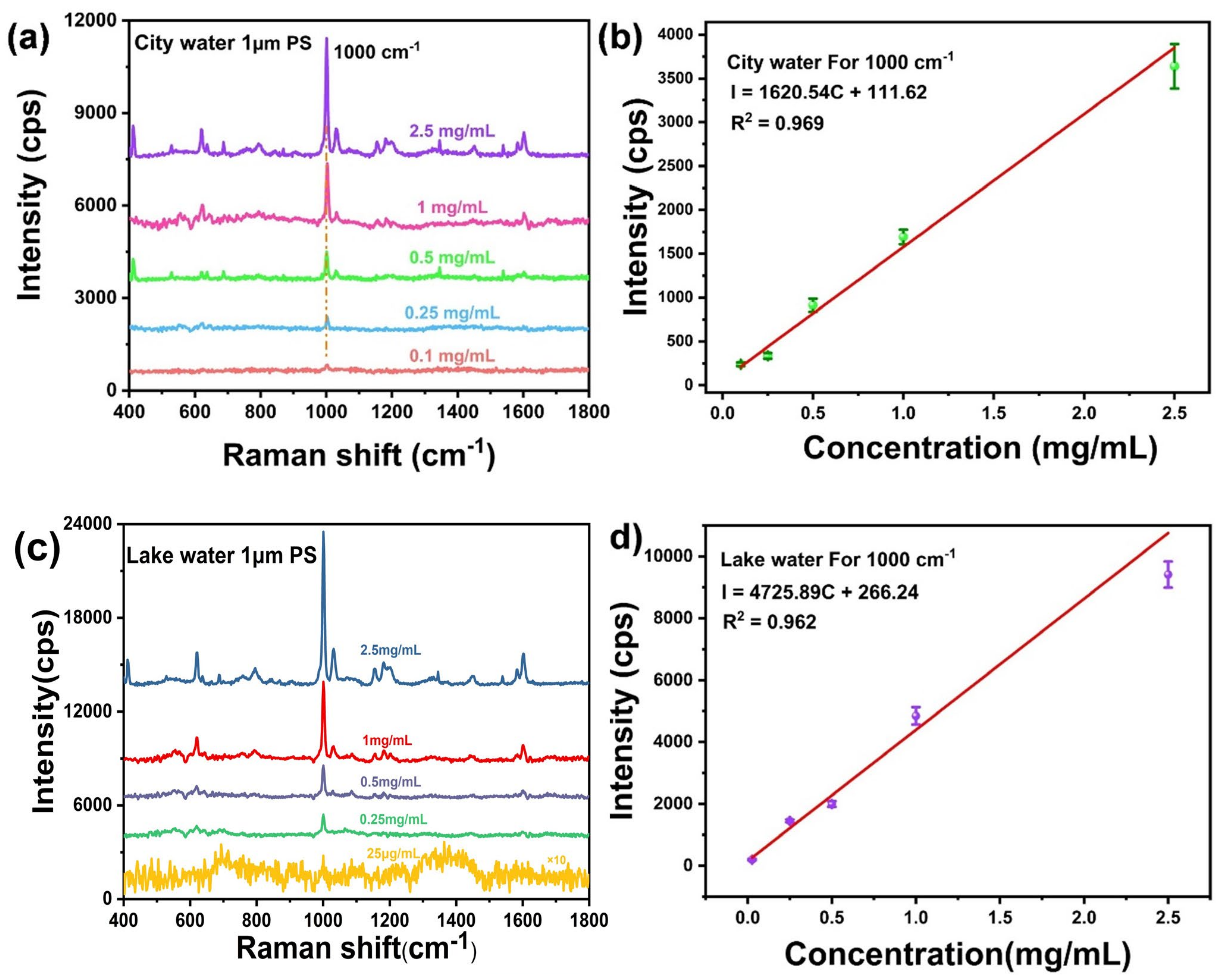
Disclaimer/Publisher’s Note: The statements, opinions and data contained in all publications are solely those of the individual author(s) and contributor(s) and not of MDPI and/or the editor(s). MDPI and/or the editor(s) disclaim responsibility for any injury to people or property resulting from any ideas, methods, instructions or products referred to in the content. |
© 2023 by the authors. Licensee MDPI, Basel, Switzerland. This article is an open access article distributed under the terms and conditions of the Creative Commons Attribution (CC BY) license (https://creativecommons.org/licenses/by/4.0/).
Share and Cite
Wang, C.; Shi, X.; Bao, Z.; Zhang, M.; Shen, Y.; Wu, Y. Semiconductor Heterojunction-AgNPs Mediated Surface-Enhanced Raman Spectroscopy (SERS) Sensor for Portable Miniaturized Detection Platform. Chemosensors 2023, 11, 490. https://doi.org/10.3390/chemosensors11090490
Wang C, Shi X, Bao Z, Zhang M, Shen Y, Wu Y. Semiconductor Heterojunction-AgNPs Mediated Surface-Enhanced Raman Spectroscopy (SERS) Sensor for Portable Miniaturized Detection Platform. Chemosensors. 2023; 11(9):490. https://doi.org/10.3390/chemosensors11090490
Chicago/Turabian StyleWang, Chenyu, Xiaoyi Shi, Zhiyong Bao, Maofeng Zhang, Yonghui Shen, and Yucheng Wu. 2023. "Semiconductor Heterojunction-AgNPs Mediated Surface-Enhanced Raman Spectroscopy (SERS) Sensor for Portable Miniaturized Detection Platform" Chemosensors 11, no. 9: 490. https://doi.org/10.3390/chemosensors11090490



